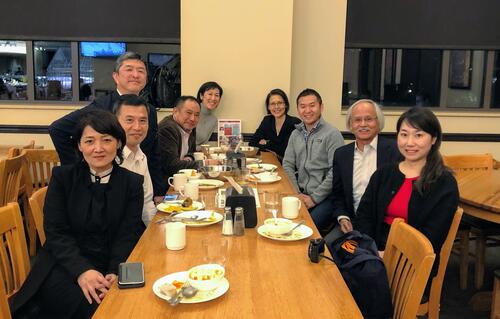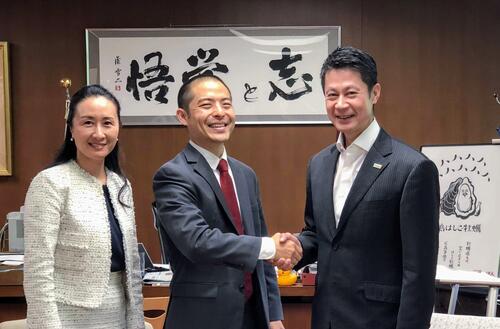SPICE/Stanford and Hiroshima
SPICE/Stanford and Hiroshima
Collaboration between SPICE and Hiroshima continues to grow.

In 2019, SPICE established two new online courses for students in Hiroshima—one for MBA students and one for high school students. These courses have a special significance to me because my ancestral home is Hiroshima. My paternal grandfather left Hiroshima for Hawaii to work as a sugar cane field laborer in 1903. After three years, he departed for California. My paternal grandmother departed Hiroshima in 1909 to join him as a “picture bride.” My maternal grandfather left Hiroshima for California to work as a strawberry field laborer in 1919, and my maternal grandmother, who was born in Hawaii and raised in Hiroshima, joined him also as a picture bride in 1931.
One of the biggest regrets in my life is that I never had the chance to meet my maternal grandfather, who returned to Japan from California in 1954 just before I was born. I wish that I could tell him that SPICE’s two new online courses for students in his birthplace were established 100 years after his arrival in California in 1919 and that this article was posted on SPICE’s website 78 years after President Franklin D. Roosevelt’s signing of Executive Order 9066 on February 19, 1942. This order led to my family’s internment—including my grandparents and parents—during World War II.
The two online courses are called the Stanford-Hiroshima Collaborative Program on Entrepreneurship (SHCPE), an online course for MBA students that was conceptualized in consultation with the Hiroshima Business and Management School at the Prefectural University of Hiroshima (PUH), and Stanford e-Japan, an online course for high school students.

SHCPE Instructor Dr. Mariko Yoshihara Yang recently shared her reflections on the inaugural course that was offered in fall 2019. On February 13, 2020, Yang welcomed PUH faculty and staff members Professor Katsue Edo, Professor Yasuo Tsuchimoto, Professor Narumi Yoshikawa, and Kazue Hiura to Stanford to debrief the 2019 course and to prepare for the 2020 course. Joining the meeting were three guest speakers for SHCPE. The guest speakers were Tasha Yorozu, a legal counsel who has worked extensively with Japanese companies in Silicon Valley; Seiji Miyasaka, an active venture capitalist on both sides of Pacific; and Tatsuki Tomita, who has established multiple startups. During the meeting, I had the chance to share the Japanese passports of my paternal grandfather and grandmother, who were born in 1882 and 1892, respectively. I have shared the passports with many Japanese visitors as a way to note their contributions—through agriculture—to early U.S.–Japan relations.
As I listened to the discussion, I came to realize the significance of the word, “Collaborative,” in the title of Yang’s course. Course feedback from the MBA students who were enrolled in SHCPE was also carefully considered as modifications for the 2020 course were mapped out. Preliminary plans were also made for a visitation to Stanford by SHCPE students following the 2020 course.
In addition to SHCPE, SPICE offers an online course for high school students in Hiroshima that is called Stanford e-Hiroshima. Stanford e-Hiroshima Instructor Rylan Sekiguchi is working with students who attend the following high schools in Hiroshima Prefecture.
- Miyoshi High School
- Sera High School
- Kuremitsuta High School
- Yasufuruichi High School
- Onomichi Kita High School
- Onomichi Higashi High School
- Hiro High School
- Hiroshima High School
- Hiroshima Kokutaiji High School
- Hiroshima University High School
- Fukuyama Junior and Senior High School
- Hatsukaichi High School
- Gion Kita High School
- Fukuyama Seishikan High School
- Saijyou Agricultural High School
I had the pleasure of sharing the stories of early Japanese immigration to the United States—including those of my grandparents—during a Stanford e-Hiroshima online class. Sekiguchi’s students were not only attentive but also asked excellent questions. They are currently in the midst of preparing and delivering their final presentations for Stanford e-Hiroshima. At the end of the course, the top two highest performing students will be invited to Stanford for a ceremony on August 17, 2020, just a few days after the 75th anniversary of the dropping of the atomic bomb on Hiroshima, August 6, 1945. I believe that my grandparents would be pleased to hear about educational efforts—such as Stanford e-Japan and SHCPE—that promote a better understanding between Americans and Japanese so that the current friendship will remain forever.

I would like to express my appreciation to Hiroshima Governor Hidehiko Yuzaki (Stanford MBA, 1995). Without his vision, SHCPE and Stanford e-Japan would not have been realized. I am grateful to those from Hiroshima—Edo, Tsuchimoto, Yoshikawa, and Hiura—and those based in the United States—Yorozu, Miyasaka, and Tomita—for having taken the time in their busy schedules to meet with Yang on February 13, 2020. In addition, I would like to express my appreciation to Superintendent Rie Hirakawa of the Hiroshima Prefectural Board of Education and Teacher Consultants, Rika Ryuoh and Nobuo Kawahara, who have been unwavering of their support of Sekiguchi and Stanford e-Hiroshima. Last but not least, I am thankful to Sekiguchi and Yang for their course leadership and for allowing me the chance to keep my grandparents’ legacies alive through their courses.
To stay informed of news about Stanford e-Japan and SPICE’s other programs, join our email list and follow us on Facebook, Twitter, and Instagram.
Related articles:
- Stanford-Hiroshima Collaborative Program on Entrepreneurship: Reflections
- Stanford Alumni Weekend (October 24–27, 2019) Feature: Hiroshima Governor Hidehiko Yuzaki & SPICE’s Dr. Mariko Yoshihara Yang and a New Online Course for MBA Students in Japan
- Stanford e-Hiroshima, SPICE’s Newest Online Course for High School Students: Sharing Cranes Across the Pacific
